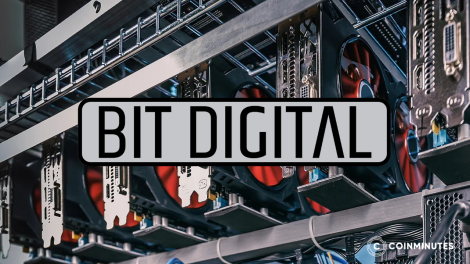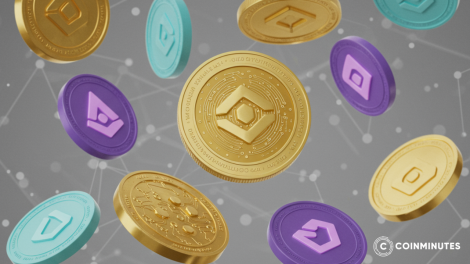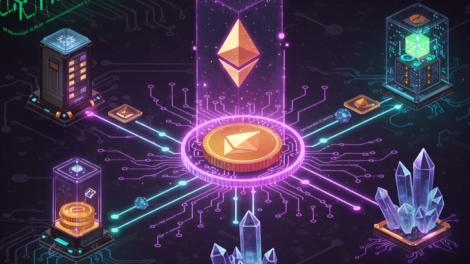What is Blockchain? Beginner's Guide to How It Works and Its Different Types

If you know Bitcoin, you might have heard of blockchain technology. It’s the technology that makes Bitcoin and all the other cryptocurrencies tick. Everyone talks about it, but only a few seem to truly understand. They think it will solve all the world's problems. It’s a technology built to remove the need for trust in people, and instead, force you to trust in cold, hard, unchangeable code. CoinMinutes will help you understand this innovative technology.
What is Blockchain
A blockchain is a shared, immutable ledger that facilitates the process of recording transactions and tracking assets in a business network.
-
It's Distributed (or Decentralized): Instead of one person or one company holding the notebook (like a bank holds its ledger), thousands of copies of the same notebook are spread across a network of computers all over the world. No single person is in charge.
-
It's Immutable: Once something is written in this notebook, it's nearly impossible to erase or change it. The entries are permanent. This is achieved through some clever cryptography.

So, a blockchain is a shared, immutable ledger for recording transactions and tracking assets. An "asset" can be tangible (a house, a car, cash) or intangible (a patent, a copyright, a brand). Bitcoin was the first application of this technology, using a blockchain to create a public ledger of all its transactions. But the technology itself can be used for much more than just digital money. It’s a new way of creating and maintaining trust between people who don’t know or trust each other without needing a middleman.
How Does Blockchain Work?
The machine has a few key parts that make it run. It's a combination of simple ideas that become powerful when put together.
The Structure of a Blockchain
The name "blockchain" is a pretty literal description of how it’s built.
-
Blocks: Data is collected and stored in "blocks." Each block has a limited storage capacity. When a block is full, it's ready to be added to the chain.
-
Hashes: Each block is given a unique cryptographic fingerprint called a "hash." This hash is generated based on the data inside the block. If you change even one tiny piece of data in the block, the hash changes completely.
-
Chains: Here's the clever part. Each new block also contains the hash of the previous block. This is what links them together, creating a "chain."
This chaining mechanism is what makes a blockchain so secure. If a hacker wanted to alter a transaction in an old block, they would change the data in that block, which would change its hash. Because the next block contains the old hash, that next block would now be invalid, and so would every single block that came after it. To successfully alter the chain, a hacker would have to recalculate the hashes for every subsequent block on thousands of computers at once—a monumental, virtually impossible task on a large, secure network.
Consensus Mechanisms
But who gets to add the next block to the chain? And how does everyone on the network agree that the new block is valid? This is handled by a "consensus mechanism." It's the set of rules the network follows to agree on the state of the ledger. The two most common types are:
-
Proof of Work (PoW): This is the system Bitcoin uses. Computers on the network, called "miners," compete to solve a very difficult mathematical puzzle. The first one to solve it gets to propose the next block and is rewarded with some newly created cryptocurrency. This process requires a massive amount of computational power and electricity, but it's what secures the network.
-
Proof of Stake (PoS): This is the system Ethereum now uses. Instead of miners, you have "validators." Validators lock up a certain amount of their own cryptocurrency as collateral (their "stake"). The network then randomly chooses a validator to create the next block. If they act honestly, they get a reward. If they try to cheat, they can lose their stake. This is much more energy-efficient than PoW.
Decentralization and Transparency
-
Decentralization: The blockchain ledger is not stored in a central location. It's distributed across a network of computers all over the world. There is no single owner. There is no central point of failure. This makes it incredibly difficult for any one person, company, or government to control or shut down.
-
Transparency: In a public blockchain, anyone can view the entire transaction history. You can see every transaction that has ever happened, from the very first one to the most recent. The addresses are pseudonymous, but the flow of money is completely transparent. There's nowhere to hide.
Types of Blockchains
The word "blockchain" gets thrown around a lot. But it's not a one-size-fits-all technology. There are different types, built for different purposes. The team at CoinMinutes often has to clarify which type of blockchain a new project is using, as it dramatically changes its profile.
Public Blockchains
This is what most people think of when they hear "blockchain." A public blockchain is completely open and permissionless. Anyone, anywhere in the world, can join the network, view the ledger, submit transactions, and participate in the consensus process (e.g., by mining or staking). There is no single entity in control. Bitcoin and Ethereum are the most famous public blockchains.
Public blockchains are highly decentralized, censorship-resistant, and transparent. However, due to the large number of participants, they can be slow and have issues with scalability. The public transaction data may not be suitable for all use cases.
Private Blockchains
A private blockchain is the opposite of a public one. A single organization controls it. That organization determines who can join the network, who can view the ledger, and who can submit transactions.

Private blockchains have high privacy, very high transaction speed, and scalability. The central organization has full control to change the rules or even alter the ledger if needed. Though it is not decentralized. It relies on trust in the central organization that controls it. Some argue that a private blockchain is just a more complicated, less efficient traditional database.
A company might use a private blockchain for internal auditing or supply chain management to securely track goods between departments without making that data public. Hyperledger Fabric is a popular framework for building private blockchains.
Consortium Blockchains
A consortium blockchain is a sort of hybrid between public and private. Instead of being controlled by a single entity, it is governed by a pre-selected group of organizations. It's more decentralized than a private blockchain but still permissioned. It offers shared control and data visibility among a group of trusted participants. It can be more efficient and scalable than a public blockchain.
Consortium blockchains still require trust among the group members. Setting up the governance rules for the consortium can be complex.
A group of major banks might form a consortium blockchain to settle interbank transactions more efficiently. A consortium of food producers and supermarkets could use one to create a transparent and shared record for tracking food from farm to table.
Hybrid Blockchains
A hybrid blockchain combines features from both public and private blockchains. A typical setup might use a private, permissioned system for most operations to maintain speed and privacy, but anchor or record proofs of its state on a public blockchain to leverage its security and immutability for auditing purposes.
Hybrid blockchains aim to get the best of both worlds—the privacy and control of a private chain with the security and transparency of a public chain. But they can be complex to design and implement.
A supply chain system might use a hybrid model where sensitive shipment details are kept on a private chain, but a final, verifiable proof of delivery is recorded on a public chain like Ethereum.
Blockchain vs. Traditional Database
So, a blockchain is a database. But how is it different from the traditional databases that have been running the world for decades? The ones that power your bank, your social media, and your online shopping. This isn't about one being better than the other; they are different tools for different jobs.
Data Structure and Storage
-
Traditional Database: Typically stores data in a client-server architecture. There is a central administrator who controls the database. Data is usually organized in tables, and it can be easily updated, edited, or deleted.
-
Blockchain: Stores data in a chain of cryptographically linked blocks. The data is distributed across a network of peers. Once data is added, it is immutable—it cannot be easily edited or deleted. It's an append-only system.

Security and Trust
-
Traditional Database: Security relies on controlling access to the central server. You have to trust the central administrator not to manipulate the data or get hacked. Trust is placed in an institution.
-
Blockchain: Security comes from its decentralization and cryptographic linking. You don't have to trust a central party; you trust the code and the consensus of the network. Trust is placed in the technology itself.
Performance and Scalability
-
Traditional Database: Highly optimized for speed and performance. They can handle tens of thousands of transactions per second. They are highly scalable.
-
Blockchain: Generally much slower. Because every transaction needs to be validated by multiple participants across a network, the throughput is much lower. Public blockchains like Bitcoin can only handle a handful of transactions per second. Scalability is a major challenge.
Use Cases
-
Traditional Database: The right tool for most standard applications—managing customer records, e-commerce inventories, social media feeds—where a central authority is desired and high performance is critical.
-
Blockchain: A specialized tool for use cases where multiple parties who don't necessarily trust each other need to share a consistent and tamper-proof record, without relying on a central intermediary. This includes cryptocurrencies, supply chain tracking, and digital identity systems.
The Pros and Cons of Blockchain Technology
Like any tool, the blockchain has its strengths and its weaknesses. The evangelists will only tell you about the good stuff. The skeptics will only point out the flaws. The truth, as always, is somewhere in the muck in between.
Pros of Blockchain Technology
-
Enhanced Security: Cheating or hacking blockchains is a daunting task due to their decentralized nature. They use cryptography to link all the records together. Every data recorded on a blockchain is permanent and cannot be changed or deleted.
-
Greater Transparency: Public blockchains are places where everyone can see all the transactions. This creates complete transparency. Everyone can check what's happening and hold each other accountable. It's perfect for a decentralized system.
-
Immutability: It's nearly impossible to change old records on a blockchain. This creates a permanent trail of everything that happened. This is valuable for things like property records, supply chain tracking, or voting systems.
-
Decentralization and Trustlessness: Blockchain removes the need for trusted third parties (like banks or lawyers). This can reduce costs, speed up processes, and allow people to interact directly and securely.
-
High Availability: Because the database is distributed across many computers, there is no single point of failure. The network can continue to operate even if a large number of nodes go offline.
Cons of Blockchain Technology
-
Scalability Issues: Public blockchains are quite slow and can only handle a limited number of transactions per second. This makes them unsuitable for high-throughput applications. CoinMinutes covers this topic extensively when discussing Layer 2 scaling solutions.
-
Energy Consumption: Proof-of-Work blockchains like Bitcoin consume a massive amount of electricity which can match that of an entire country. This has led to serious environmental concerns.
-
Complexity: Blockchain technology is complex and not many people can understand it well. Building and maintaining blockchain applications requires specialized expertise.
-
User Responsibility and Risk: In a decentralized system, the user is often responsible for their own security. If you lose your private keys, there is no one to call to get them back. Your funds are simply gone forever.
-
Immutability is a Double-Edged Sword: The fact that you can't change the record is great for security, but what if there's a legitimate mistake? What if a smart contract has a bug? Reversing transactions or fixing errors can be extremely difficult or impossible.
The Future of Blockchain
The hype cycle is starting to cool. The talk of blockchain solving world hunger is fading. What’s left is a slow, steady exploration of where this technology actually makes sense. The future isn't just about cryptocurrency.
-
Supply Chain Management: Imagine scanning a QR code on a bag of coffee and seeing its entire journey, from the farm in Colombia to your local store, all verified on a blockchain. This increases transparency and fights counterfeiting.
-
Digital Identity: You could have a secure, self-owned digital identity on a blockchain, giving you control over who sees your personal data.
-
Healthcare: Medical records could be stored securely and shared between doctors and hospitals with your explicit, verifiable permission.
-
Voting Systems: Some believe blockchain could be used to create secure and transparent voting systems, though this is a highly complex and controversial idea.
-
Interoperability: The future involves different blockchains being able to communicate with each other, creating a network of networks.
The technology is still in its early days. It’s like the internet in the early 1990s—clunky, slow, and full of strange experiments. Most of them will fail. But as a member of the CoinMinutes community once said, "Even if 99% of these projects die, the 1% that survives could change everything."
The Bottom Line
A blockchain is a machine. A slow, clunky, and inefficient machine that produces one thing: trust. It allows a network of strangers to agree on a set of facts without needing to trust each other. That is a radical idea.
It has been buried under a mountain of hype, speculation, and empty promises. But underneath all that noise is a simple, powerful piece of engineering. It’s a new kind of foundation. What people will build on top of it—or whether they will build anything lasting at all—is a question that is still being answered, one block at a time.
 English
English
 Vietnamese
Vietnamese
















